2023 Emergency Management Accomplishments Report
EPA’s Emergency Management Program works to ensure the protection of human health and the environment by preparing for, preventing, and responding to natural disasters and environmental emergencies. The following accomplishments highlight national and regional responses and removal actions from October 1, 2022, to September 30, 2023. The highlights include inspection data and information about prevention and response regulations and consequence management.
Emergency Preparedness and Prevention
National Contingency Plan Subpart J Amendments
In June 2023, EPA finalized amendments to Subpart J of the National Contingency Plan. Subpart J governs the listing and use of dispersants and other chemical and biological agents when responding to oil discharges into waters of the United States and adjoining shorelines. The final rule amends the Subpart J provisions for listing agent products. The amended and new provisions in the final rule are intended to improve the safety and effectiveness of spill mitigating product use, ensure emergency responders have sufficient information to make better decisions about product use, and better target the use of these products to reduce the risks from oil discharges and response technologies.
State Emergency Response Commission Survey
In April 2023, EPA published a report on the first survey conducted of the State Emergency Response Commissions. The purpose of the survey was to learn how the Emergency Planning and Community Right-to-Know Act is currently implemented at the state and local levels, as required by the 1986 legislation, as well as its amendments of certain provisions in 2018. State Emergency Response Commissions are responsible for implementing the EPCRA provisions in each state and territory. The agency conducted this survey to gather information on current practices, challenges, and gaps, including successes and best practices in implementing EPCRA. Additionally, EPA asked the states to provide information on their Local Emergency Planning Committees and if their planning districts have developed or updated response plans to address potential chemical accidents.
Note: The agency received responses from 50 states and two territories. A few states omitted responses to some of the questions; however, the report includes an analysis of responses to all 86 questions in the survey.
Inspections at Chemical and Oil Facilities
To ensure compliance with EPA prevention and preparedness regulations, the agency trains and provides resources to regional inspectors for oversight of chemical and oil facilities. Inspections and government-initiated unannounced exercises can result in enforcement actions to ensure facilities comply with regulatory requirements and to protect human health and the environment.
-
EPA regions have completed 348 Spill Prevention, Control, and Countermeasure inspections to date in Fiscal Year 2023 with a focus on high-risk SPILL PREVENTION, CONTROL, AND countermeasure facilities.
-
Completed 175 Facility Response Plan inspections and 47 on-site government-initiated unannounced exercises through August 2023.
Inspector training:
-
Spill Prevention, Control, and Countermeasure/FRP Training:
-
Inspector “Tank Talk” webinars: Spill Prevention, Control, and Countermeasure/FRP Refresher – December 2022
-
Midland College Oil Production Course (Midland, Texas) – February 2023
-
Five-day Oil Inspector Training course (San Francisco) – June 2023
-
Two-day Advanced Oil Program Inspector Refresher Training for Regions 2 and 3 (Philadelphia) – July 2023
-
Nine virtual Oil Inspector Refresher Training sessions throughout FY23
-
Four webinars for Spill Prevention, Control, and Countermeasure for Federal Facilities in September 2023
-
Risk Management Program Inspector Training:
-
Completed five-day RMP Inspector Training course (November 2022)
-
Completed three-day RMP Ammonia Refrigeration Systems, Technology, and Safety Training course (June 2023)
Tribal Training and Outreach
Environmental emergencies may occur on tribal lands, so it is important for Tribal communities to be prepared and implement necessary prevention measures. Throughout the year, EPA has enhanced outreach, training, inspection targeting, and coordination with tribes to improve implementation of these programs in Indian Country. The agency provided free webinars and inspector training to educate tribes on their responsibilities to prevent and prepare for oil discharges and chemical emergencies, including:
-
Spill Prevention, Control, and Countermeasure and Computer-Aided Management of Emergency Operations webinar – 4 sessions from March to September 2023
-
Overview of oil spill prevention techniques 4-hour short courses – 3 sessions from March to September 2023
-
EPCRA webinar - 6 sessions from March to May 2023
Consequence Management
Airborne Spectral Photometric Environmental Collection Technology (ASPECT) aircraft aerial radiological survey
The EPA’s Airborne Spectral Photometric Environmental Collection Technology aircraft and associated agency team conducted an aerial radiological survey of Erie and Niagara counties throughout October 2023 at the request of EPA Region 2 and the New York State Department of Environmental Conservation. Western New York was a hub for the manufacturing of atomic weapon components during World War II. This aerial survey was performed to assess the extent of potential use and distribution of byproducts and waste material containing radiological material. EPA Region 2 and the NYDEC have ongoing Superfund removal actions of radiological materials in the area which cause an imminent and substantial endangerment to human health and the environment. Additional ASPECT flyovers are planned for later in the year.
Chemical Warfare Agency Preparedness Training
In March 2023, EPA facilitated the Chemical Warfare Agent Preparedness Training event in Franklin, Indiana. The goal of the training was to better prepare emergency response personnel to respond to chemical warfare incidents. The comprehensive training provided OSCs and Special Teams with hands-on experience in various areas related to chemical warfare response, including handheld monitors, sampling, decontamination, personnel decontamination, laboratory analysis, waste management, health effects and medical countermeasures, and generating clearance values. The training also featured demonstrations from EPA’s ASPECT aerial detection system, the Federal Bureau of Investigation, Indiana National Guard 53rd Civil Support Team, and the U.S. Army Chemical Biological Center.
The training event was attended by over 60 participants from EPA, other federal agencies, and state, and local emergency responders. This collaborative arrangement helped prepare the nation for the potential impact caused by chemical warfare incidents.
Testing Chemical Agent Contamination Response in a Realistic Setting
EPA is enhancing the nation’s ability to respond to and recover from a potential chemical agent incident through research and response exercises. In October and November 2023, EPA tested its chemical agent contamination response in a realistic setting at the Muscatatuck Urban Training Center in Indiana. This effort to further advance preparedness was called the Operational Testing and Evaluation of Remediation Activities field study.
EPA collaborated with other partners to engage in real-world scenario testing of an indoor chemical warfare agent release. The interior of a building was configured to simulate two types of spaces many people frequently find themselves in: an office space and a studio apartment. These rooms included common items that would need to be remediated in the event of a chemical warfare agent incident and provided the participants with different types of materials to work with, including tables, IT equipment, bed, countertops, and kitchen appliances.
The simulated scenario provided EPA responders and researchers an opportunity to understand the operationally relevant effectiveness of sampling and analytical methods and decontamination approaches. Activities included an initial contamination event, followed by pre-decontamination sampling, decontamination, post-decontamination sampling, with waste management, and data management conducted throughout the exercise.
The team merged emergency preparedness exercises with cutting edge research to advance chemical warfare agent emergency response. This comprehensive exercise transformed the way we collect and tag samples, minimizing time the responders would be in the field and potentially exposed to the agents. It also streamlined the process for tagging and documenting chains of custody. For more information, see the video on the OTECRA field study.
Updated Quick Reference Guides for Responders
EPA works with the National Response Team to prepare and update quick reference guides as tools for the response community on various hazards. These updates help ensure that responders have current information to effectively respond to a wide range of incidents. In FY23, quick reference guide updates were provided for the following chemical warfare agents: Sulfur mustard, Mustard-Lewisite mixture, and Lewisite.
Emergency Response
Nationally/Regionally Significant Responses and Removals
Discharges and Spills
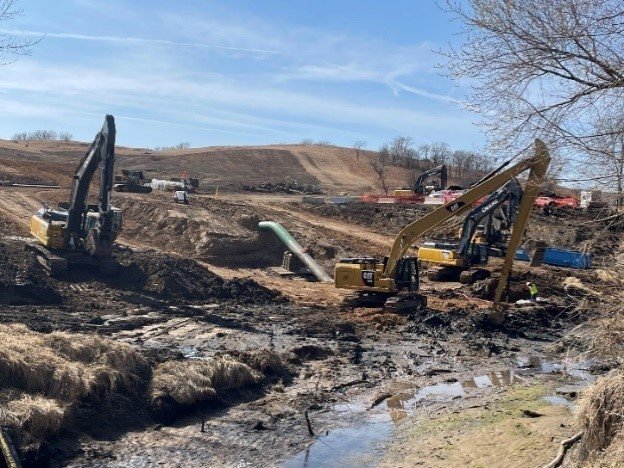
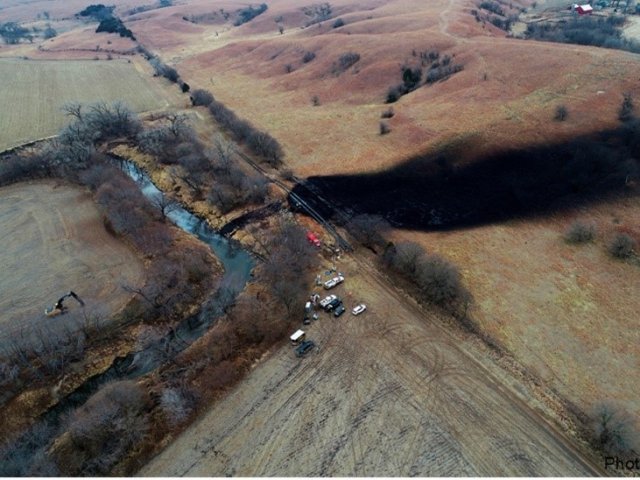
Oil Pollution Act -TC Energy Mill Creek Oil Spill Emergency Response – On December 7, 2022, the 36-inch Keystone pipeline near Washington, Kansas, ruptured, resulting in the discharge of 588,000 gallons of heavy crude oil. The oil flowed overland and into Mill Creek--a perennial stream. The stream was significantly impacted with oil bank-to-bank greater than 3.5 miles from the pipeline rupture location. EPA On-Scene Coordinators deployed to oversee responsible party containment and oil recovery operations. Numerous traditional and innovative oil recovery techniques were used to combat terrain and extreme weather conditions, including a record low temperature of -13°F on December 23, 2022. On May 11, 2023, oil removal activities within Mill Creek and the surrounding shoreline were deemed complete. Response crews then shifted focus to stream restoration, which continued through the summer.
EPA worked more than 6,000 staff hours and had over 83 deployments to the scene during this major oil spill response. EPA offices from all over the country supported the effort, along with staff from the U.S. Coast Guard Atlantic Strike Team. In total, more than 54 million gallons of contaminated water were treated and discharged back to Mill Creek during the response. A total of 711,000 gallons of oil were recovered, including product remaining in the pipeline following the rupture. Approximately 200,000 tons of oil-impacted soil, sediment, and debris were excavated and sent for off-site disposal. Stream restoration efforts were completed during the summer and early fall of 2023. On October 13, 2023, water levels were returned to their natural levels in Mill Creek.
Explosions and Fires

My Way Trading Warehouse Fire – On April 11, 2023, the My Way Trading warehouse, a former industrial plastic recycling facility, in Richmond, Indiana, caught fire. The Richmond Fire Department established a ½-mile evacuation zone and issued a shelter-in-place order for residents outside the ½-mile limit. The Indiana Department of Emergency Management requested EPA assistance with air monitoring and sampling. EPA integrated into a Unified Command with IDEM, Ohio EPA, the City of Richmond Fire Department, and Wayne County EMA. The agency initially conducted mobile and stationary air monitoring in the community. The intensity of the fire destroyed the My Way Trading warehouse as well as three neighboring warehouses. During the height of the fire, a smoke plume was visible up to thirty miles away and deposited fire debris over ten miles from the scene. The fire lasted for about eight days before being completely extinguished.
Fire debris sample results confirmed the presence of asbestos-containing material. EPA crews safely removed this debris from the community. EPA prioritized cleanup of schools, daycares, public parks and residences in Indiana and Ohio. The agency cleaned up 351 properties and performed reconnaissance at an additional 512 properties where no evidence of debris was present. In the fall of 2023, the agency initiated an action to remove contaminated debris from the site.
Floods

Vermont Floods – In early July 2023, the state of Vermont experienced extreme rainfall which caused catastrophic flooding across several counties. Due to the damage caused by the flooding, the state of Vermont requested FEMA support. EPA immediately stood up a Regional Emergency Operations Center and established an Incident Management Team. The agency deployed two On-Scene Coordinators and START and ERRS contractors to conduct assessments and response activities. Additional work included the assessment of wastewater treatment facilities. As the response grew over the following weeks, an additional OSC was deployed to the field, along with two Assistant Safety Officers.
Assessments were conducted in 10 towns in coordination with the U.S. Army Corps of Engineers and the Vermont Department of Environmental Conservation representatives to determine the operability status of wastewater treatment facilities. After approximately two weeks of assessments, it was determined that no further EPA action was required.
Additionally, assessments were conducted in 17 towns across six counties to identify any releases or potential releases of oil and hazardous materials due to the flooding, and response actions were conducted as necessary to mitigate any releases. By the end of the response, a total of 202 assessments and 113 removal activities were conducted. EPA collected, separated, packaged and sent approximately 14,000 containers for disposal to a permitted facility. All field teams were demobilized from the incident by mid-September 2023.
Hurricanes and Storms

Typhoon Mawar – On May 24, 2023, Typhoon Mawar made landfall in Guam as a Category 4 typhoon. In less than a week, amid airport and road closures, power outages, and drinking water shortages, two EPA OSCs were deployed to perform damage assessments and set up an Incident Management Team to support operations for this disaster.
EPA demonstrated outstanding resilience and collaborative teamwork with local and federal agency partners to rapidly stand up and execute to completion the removal of household hazardous wastes following the impacts to the island of Guam from Typhoon Mawar. The underserved communities in Guam have been disproportionally impacted by a slow recovery from the last Super Typhoon that impacted the Western Pacific region of the Commonwealth of the Northern Marina Islands in 2018 and the difficulties encountered to manage and remove hazardous waste on a remote island with complex international logistics considerations.

The Mawar IMT conducted real-time environmental monitoring, Uncrewed Aerial Systems mapping, thermal and digital imaging activities, and preparation for hazardous waste and electronic waste debris removal. EPA worked closely with Guam EPA, FEMA, the U.S. Coast Guard, Army National Guard, and the U.S. Army Corps of Engineers to conduct the household hazardous waste removal over a four-month period.
The Mawar team successfully removed over 80 tons of batteries, 4,000 compressed cylinders, 1,800 cubic yards of electronic waste, and 33,000 gallons of flammable liquids. Additionally, the team worked closely with Guam EPA and the USACE to set them up for success in addressing any remaining hazardous waste during the removal of debris.
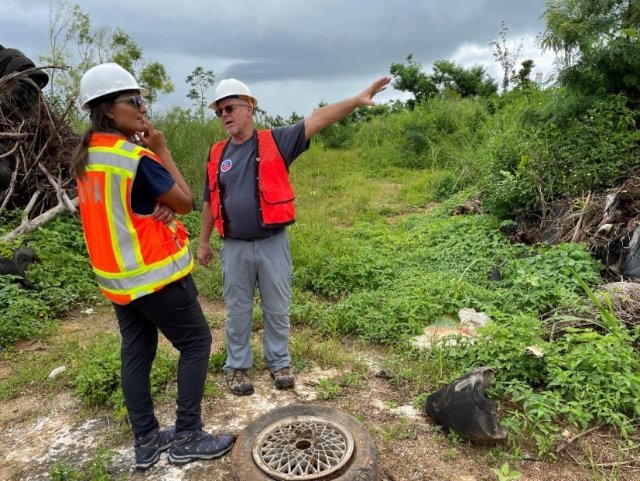
Derailments
East Palestine – On February 3, 2023, a Norfolk Southern Railway train derailed in East Palestine, Ohio, releasing large quantities of hazardous substances, causing a massive fire, and leading to the evacuation of thousands of residents. EPA On-Scene Coordinators responded within hours. During the following months, hundreds of people across the agency supported the response either in the field or virtually. EPA's Airborne Spectral Photometric Environmental Collection Technology aircraft and Portable High-throughput Integrated Laboratory Identification System deployed in support of the response.
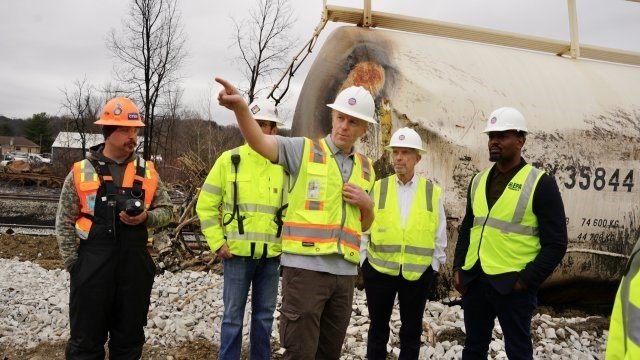
The agency directed and oversaw the collection of more than 100 million air monitoring data points and more than 35,000 environmental samples (air, water, and soil) in and around the community. OSCs and support personnel demonstrated exceptional leadership and collaborative problem-solving skills throughout the East Palestine disaster. Their efforts have ensured the safety and well-being of the community.
Although some activities at the site are still ongoing, the cleanup effort has resulted in the removal of approximately 175,000 tons of solid waste and almost 40 million gallons of hazardous wastewater (with over 5 million gallons of wastewater treated on site).
Sandstone Derailment – On March 8, 2023, a CSX train consisting of four locomotives with 109 empty coal cars collided with a boulder that had fallen across the track in Sandstone, West Virginia. The locomotives, holding approximately 11,000 gallons of diesel and 1,600 gallons of lubricating oil derailed with two entering the New River within New River Gorge National Park. EPA, National Park Service, and the West Virginia Department of Environmental Protection all responded to the derailment. EPA supplemented sampling from the WV American Water drinking water intake on the New River and coordinated with the facility operator during an 8-hour shutdown of the intake and throughout the response.
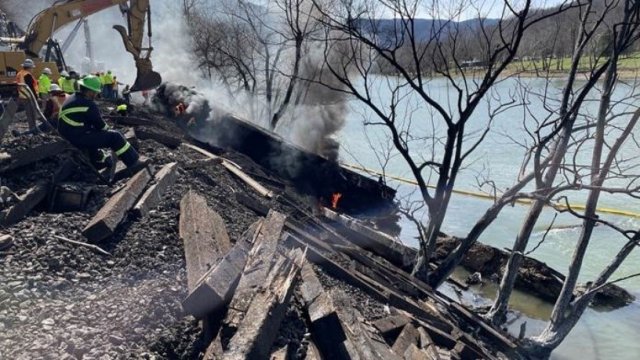
CSX's early response efforts included boom deployment, soil excavation to bedrock at the derailment site, product recovery on the river, air monitoring, and surface water sampling. All response activities were overseen by EPA and WVDEP. Efforts included multiple controlled water flushes and product recovery events at the derailment site and ongoing product recovery and monitoring of the bank.
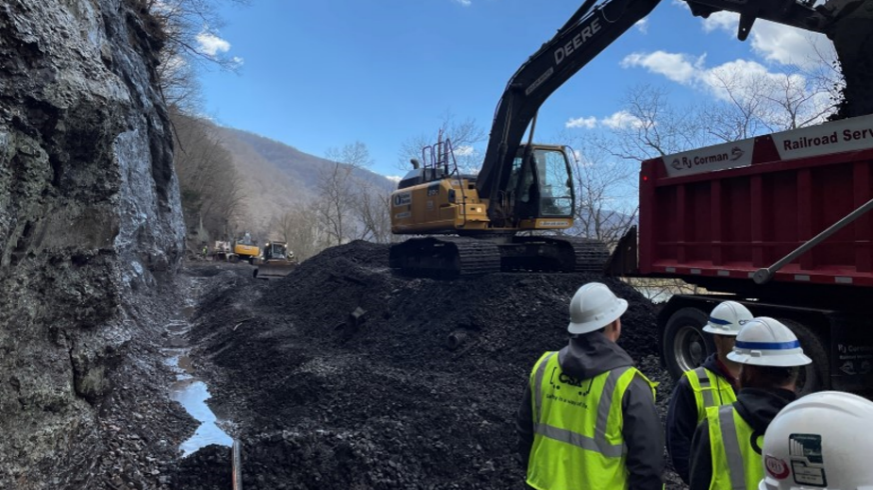
Wildfires
Maui Wildfires – On the evening of August 8, 2023, winds from Hurricane Dora helped spread wildfires rapidly across the island of Maui, Hawaii, devastating the communities of Lahaina, Kula, and Olinda. On August 10th, President Biden approved an Expedited Major Disaster Declaration. By August 11th, EPA began the process of conducting the removal and disposal of household hazardous materials to protect public health and safety in impacted communities.

EPA deployed key members of its Incident Management Team on-island, laying the groundwork for a nationally significant, multi-month disaster response effort. The Maui wildfires resulted in nearly 100 fatalities, 2,170 acres burned, and 1,600 parcels referred to EPA for household hazardous material removal. By the end of fiscal year 2023, EPA completed 65% of its $41 million FEMA Mission Assignment work, including Uncrewed Aircraft Systems surveying, soil stabilizer evaluation and pilot application, and groundbreaking lithium-ion battery deconstruction processes to enable safe collection, transportation and disposal/recycling of fire-damaged power walls and electric vehicles throughout the burn areas.

The intensive approach to incorporating appropriate cultural resource practices into this EPA disaster response is both precedent setting and contributed to the overall success of the mission. From the beginning of the response, EPA committed to conducting work in a manner that aligns with and respects local culture and the devastation experienced by communities in Lahaina and the Upcountry. The agency worked with traditional practitioners with specialized knowledge of local cultural resources and practices to help achieve cleanup goals in a manner acceptable to communities suffering huge losses. The approach was memorialized in a Cultural Awareness, Resources, and Historic Properties Plan to guide the agency’s staff and contractors and includes cultural resources training as a part of EPA and contractor staff onboarding to the response. EPA worked with Na 'Aikane o Maui Cultural and Research Center and West Maui Community Aid, a collective of Native Hawaiian leaders, to ensure response actions did not further damage cultural resources. Multiple community members provided direct input to EPA’s operational planning; Na 'Aikane and West Maui Community Aid identified local cultural monitors and provided them with the proper health and safety training to accompany the field teams during cleanup operations in Lahaina. This integrated cultural resources approach to disaster response in Maui established the standard for conducting this type of work in the community with FEMA and USACE committing to continue these practices through the next phase of debris removal.

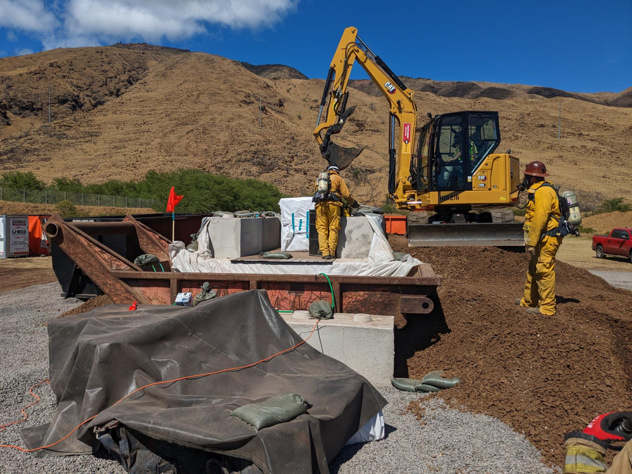
Additional Responses and Removal Actions
Columbia Smelting and Refining Works Site – The Columbia Smelting and Refining Works Site is the location of a historic secondary lead smelter which had become a portion of one of Brooklyn, New York’s largest and most popular parks and includes numerous athletic fields used by children. The Red Hook Recreation Area is located across the street from a public housing complex with approximately 6,000 residents. The agency’s sampling identified lead concentrations in soil as high as 8,300 mg/kg attributable to the former smelting operations in two areas of the park, totaling approximately 7.6 acres in size.

The EPA first worked with the property owner, the New York City Department of Parks and Recreation (NYC Parks), to temporarily restrict access to the portions of the park where elevated lead levels were identified. The agency compelled NYC Parks to conduct a cleanup of these impacted areas valued at well over $30 million, which led to a full park redevelopment project over more than 58 acres. NYC Parks excavated and properly disposed of soil impacted by the former lead smelter, capped remaining impacted soils with climate- and flood-resilient features and redeveloped the park. With vigilant oversight, review, and input by the EPA Removal Program over the course of five years, NYC Parks fully restored the impacted park areas to synthetic turf fields for the surrounding community to use. The EPA and NYC Parks held numerous public meetings with the community and many diversified groups to update them on the progress and completion of the park construction and restoration. The cleanup compelled the unrelated restoration of the adjacent, lead-contaminated housing complex to follow stringent cleanup and environmental monitoring standards and helped to revitalize a historically underserved and highly diversified community.
Vo-Toys Site Removal Action – EPA oversaw the removal of a large, historic industrial complex covering a city block within a densely urban, residential area of Harrison, NJ, which was grossly contaminated with elemental mercury from historic manufacturing processes. Air modeling confirmed the potential for a drastic, catastrophic release of mercury vapor reaching as far as New York City in the event of a building fire. Physical tracking of mercury remained a concern for the duration of the work due to its prevalence across the site.
EPA compelled the responsible party to dismantle and remove the buildings, including utility line relocation, and remove highly contaminated subsurface footers, foundations, piping and soil--over the course of three years--in coordination with local emergency response officials, state partners, many hundreds of residents, and other stakeholders. The cleanup was valued at well over $15 million and advanced the EPA Removal Program’s expertise in mercury contamination and cleanups. This complex and innovative project was critical for the protection of public health and prepared the site for beneficial reuse of an attractive location seated alongside a major commuter line, contributing to the growth of a historically underserved and vibrant community.
Port Hamilton Refining and Transportation – Port Hamilton Refining & Transportation owns the eastern portion of the approximately 1,500-acre former HOVENSA refinery located on St. Croix, U.S. Virgin Islands. HOVENSA declared bankruptcy in 2015, and the refinery was acquired by Limetree Bay Refining in 2016; LBR intended to restart operations. The attempt to start up the refinery in 2020 failed due to a series of releases that impacted the adjacent community, and in June 2021, LBR announced that it was suspending plans to restart the refinery. The refinery remained idled until it was purchased by PHRT in January 2022 and is currently in this state.

After a large pile of petroleum coke stored on site began to smolder, sending smoke and particulate matter throughout the surrounding community for 23 days, EPA scheduled a General Duty Clause inspection at the refinery in September 2022. Based on the findings of that inspection, on December 5, 2022, PHRT entered into an Order on Consent with EPA which required the removal of three highly hazardous materials: 8,400 gallons of ammonia, 26,700 gallons of liquified petroleum gas, and 327,112 gallons of an enriched amines solution that contained hydrogen sulfide. The removal work, which took place during the spring and summer of 2023, was performed by PHRT and was required due to the corroded condition of the containment vessels, the piping, and the valves. EPA personnel provided oversight during the removal activities and around-the-clock air monitoring, which displayed real-time air monitoring results online.
Air monitoring focused primarily on the chemicals of concern associated with the removal operations of the ammonia, rich amine solution and LPG, which included sulfur dioxide, nitrogen dioxide, ammonia, and hydrogen sulfide. The team, which consisted of OSCs and Emergency Response Team staff members, set up and maintained fixed air monitoring locations strategically located on the facility, on the fence line of the facility, and at locations in the nearby community for a total of 20 air monitoring stations consisting of 55 air monitors. The EPA coordinated extensively with territorial agencies on the air monitoring strategy, action levels, and public communications. To assist in the communications effort, the agency developed an ArcGIS Hub Site, which displayed real-time air monitoring readings, as well as provided information pertaining to the air monitoring and chemical removal operations. The EPA also staffed a 24-hour hotline for receiving public inquiries, as well as providing a means for the public to report odor issues. If an odor complaint was received in an approximate two-mile radius from the facility, the EPA would deploy a roving air monitoring team to investigate the source of the odor. This information was also displayed on the hub site which allowed the public to see where odors were being reported and what actions the EPA took in response.
Looking Ahead
During FY24, EPA will continue to protect vulnerable communities from chemical accidents and the discharge of hazardous substances through new regulations. As climate change impacts steadily increase the prevalence of natural disasters, the agency is looking for ways to adapt by using new technologies, tools, and resources. Protecting human health and the environment by preparing for, preventing, and responding to natural disasters and environmental emergencies is essential, and EPA is committed to building on its mission.
